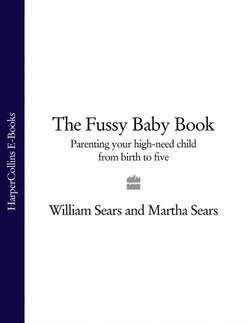Читать книгу The Fussy Baby Book: Parenting your high-need child from birth to five - Martha Sears - Страница 56
should baby cry it out?
Оглавление“But is there a time when I should leave my baby to cry?” you may wonder. As a new mother you are vulnerable to all kinds of well-meaning advisers, each of whom bears his own bag of tricks to dump on you whether you want them or not. The most damaging of all this free advice is “leave your baby to cry it out”. This often given, yet seldom helpful, advice shows a lack of understanding of the signal value of the infant cry and of the receptive qualities of the listening mother. This advice serves no useful purpose; if followed, it usually desensitizes a mother to her baby and creates a distance between the members of the communicating pair.
As a teacher, my training in child development kept haunting me. I remember learning that the social and emotional growth of a child begins with the stage of trust versus mistrust. Jason would either learn trust in his environment or learn various degrees of mistrust. Even if we could not alleviate his discomfort, we could at least hold him and rock him and let him know we cared. Abandoning him to suffer alone in a cot down the hall seemed cruel and inhumane. If we could not comfort him, at least we could teach him to learn to trust.
No one should ever advise a mother to let her baby cry it out, but neither should a mother feel that it is her responsibility always to stop her baby from crying. In the following discussion we want to help you work out the cry-response communication network that works best for you. If, when, and how long to let your baby complain is a cry-by-cry judgment. These following considerations can help you make the right judgement.
How the cry-it-out advice got started. In light of what we now know about infant development, the cry-it-out advice should be put in its proper place – filed away in the archives of bad baby advice; yet this dreadful advice is still around. Why? Understanding the historical setting that bred this philosophy makes it easier to appreciate why this advice is still so common. This sad story began in the late 1890s, when drastic changes occurred in parenting, ones that, like a contagious disease, are still around infecting parenting practices a hundred years later. This was the era when, due to a variety of social and economic situations, experts entered the business of advising women on childbearing and child rearing. Traditional motherly wisdom fell out of favour and new “scientific” theories took over. Pregnancy and birth became a medical “disease” from which a woman needed to be delivered. Man-made formula replaced mother-made milk. Rigid schedules replaced flexible feeding routines. The infant cry became an annoyance to be squelched, not a signal to be listened and responded to. “What should I do when my baby cries?” was a question that mothers should never have had to ask in the first place, and advisers should not even have attempted to answer.
Once “scientific” notions of baby tending did away with mother’s intuition, demand rose in the baby-advice market, and a multitude of advisers rushed in to supply what was needed. The most prevalent parenting theory of the time was that parents must be strict and in control, that babies and children should follow rigid, prescribed routines, and that parents who didn’t follow this advice to the letter were likely to raise spoiled and wildly uncontrollable children. If parents listened to their baby rather than to the books, they were not in control and their babies were manipulating them. To rescue parents from the fearful prospect of losing control, baby-care advisers handed out quick and easy rules to help parents control their children. The chief vaccine against the disease of manipulation was “let baby cry it out.” This was not just a suggestion, it became a mandate. This advice even came with a schedule of the predicted results: baby will probably cry one hour the first night, forty-five minutes the second night, and so on. Every new cry adviser had his own timetable: “Leave baby to cry five minutes before the first time you go in to reassure him, ten minutes the second time …”
